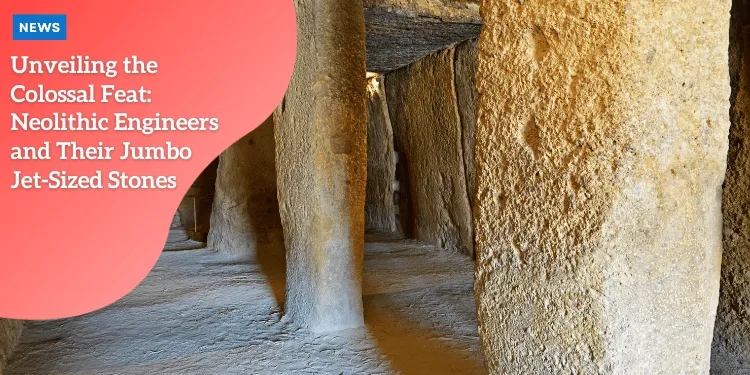Unveiling the Colossal Feat: Neolithic Engineers and Their Jumbo Jet-Sized Stones

Nestled in the picturesque heart of southern Spain, the Menga Dolmen dazzles as a marvel of Neolithic engineering, standing the test of time for 5,600 years.
Anúncios
This monumental structure is comprised of 32 colossal stones, dwarfing even the famed megaliths of Stonehenge.
Its single-chamber tomb spans an impressive 25 meters in length and 5 meters in width, serving as a testament to the ingenuity and perseverance of ancient societies.
The sheer scale of the Menga Dolmen is mind-blowing. The largest stone tips the scales at a staggering 150 metric tons—about the weight of a blue whale.
Anúncios
To put it in context, the total weight of these megaliths is roughly 1,140 metric tons, akin to two fully loaded Boeing 747 jets.
Constructing this colossal edifice would have required astonishing precision, particularly considering the tools and techniques available during the Neolithic era.
The stones were meticulously placed and carved using advanced tools, such as plumb levels and framing squares.
Anúncios
The upright stones have a consistent inward lean of 84-85 degrees, an engineering marvel that speaks to a profound understanding of geometry and stability mechanisms.
The Menga Dolmen was not just thrown together; it was engineered for durability.
The stones were embedded in deep foundation sockets with counterweights, forming a trapezoid-shaped chamber covered by a soil mound, adding insulation and seismic resilience.
Transporting such immense stones would have been no small feat.
The quarry, 850 meters away and 50 meters higher, provided the raw materials.
Ingenious Neolithic builders likely employed wooden sledges and ropes and constructed a trackway to move these behemoths with minimal friction.
This monumental structure is a remarkable embodiment of Neolithic “creative genius” and “early science.”
It demonstrates an advanced comprehension of physics, friction, angles, geology, and geometry, reshaping our understanding of technological capabilities from that era.
Coming from an age when agriculture was just settling in and without the written word, the Menga Dolmen stands as a silent yet eloquent witness to human ingenuity and scientific prowess, unassailable through the millennia.
The Magnitude of the Megaliths
The Menga Dolmen in southern Spain is a wonder of Neolithic engineering, with each of its 32 massive stones dwarfing the famous megaliths of Stonehenge.
The largest stone in the dolmen weighs around 150 metric tons, which is roughly the weight of a blue whale.
Think about it—moving a blue whale inland and setting it upright is no small feat!
This largest stone is nearly five times heavier than the biggest component of Stonehenge, showcasing an astonishing level of dedication and ingenuity from those ancient builders.
Weights and Measures
Collectively, the stones that make up the Menga Dolmen weigh an incredible 1,140 metric tons.
To put this into perspective, that’s comparable to the combined weight of two fully loaded Boeing 747 airplanes.
Imagine the sheer amount of effort it would have taken to transport these stones from the quarry to their final resting place.
The logistical challenges alone are mind-boggling.
The Astonishing Comparison
Leonardo García Sanjuán, a professor of prehistory at the University of Seville, aptly noted, “The weight is more than two Boeing 747 airplanes combined, the ones that fly across continents and so on, fully loaded with fuel and passengers.”
It’s not just a marvel in terms of weight, but also a perplexing engineering puzzle that has intrigued scientists and historians alike.
Transitioning Forward
The massive scale and precision of these constructions suggest a deep understanding of physics and engineering.
This leaves us to wonder more about how precisely these Neolithic people achieved such feats, a topic that will be explored as we delve deeper into their remarkable construction techniques.
Neolithic Engineering Precision
Carving and placing the stones of the Menga Dolmen was a precise and sophisticated endeavor.
The Neolithic builders demonstrated incredible skill in their craft, using advanced tools like plumb levels and framing squares to ensure consistency and accuracy.
Advanced Tools for Precision
The construction of the Menga Dolmen required tools that were far ahead of their time.
These early engineers used plumb levels and framing squares to measure angles and ensure the stones were perfectly placed, which led to the creation of a stable and enduring structure.
Such tools allowed the builders to achieve millimetric precision, making it clear that they had a deep understanding of geometry and design.
Consistent Inward Lean
Each of the upright stones in the Menga Dolmen was tilted inward at a uniform angle of 84-85 degrees.
This deliberate leaning created a trapezoid-shaped chamber that not only added stability to the structure but also demonstrated an advanced understanding of load distribution.
The consistent angle across all the stones suggests that the builders meticulously planned each element of the dolmen.
Seamless Fit and Design
The stones were not only placed with precision but also carved to fit seamlessly together.
Each block was designed to lock into the next, creating an interlocking structure that was both strong and resilient.
This level of craftsmanship required an extraordinary eye for detail and an understanding of stone properties and behaviors.
Structural Embedding for Stability
The builders went a step further by embedding the stones deeply into foundation sockets, likely using counterweights.
This technique ensured that up to one-third of each stone was below ground, providing additional stability.
The dolmen was then covered with a soil mound, which acted as insulation against the elements and added seismic resilience.
By showcasing their expertise in these techniques, the Neolithic builders left behind a monument that continues to intrigue and inspire.
The engineering marvel of the Menga Dolmen reflects a profound comprehension of early science and creative genius, setting the stage for further exploration of its innovative construction methods.
Innovative Construction Techniques
Embedding Stones into Deep Foundation Sockets
One of the remarkable techniques of the Neolithic engineers at Menga Dolmen was embedding stones into deep foundation sockets.
The upright stones, often leaning inward at a precise angle of 84-85 degrees, were set in these sockets to provide a strong base.
But how did they achieve such stability?
The builders likely used counterweights to lower the massive stones into place, ensuring they were solidly embedded in the earth.
This method not only stabilized the stones but also provided a firm grounding for the immense structure.
It’s a brilliant example of early science at work, demonstrating an understanding of weight distribution and leverage.
Creation of a Trapezoid-Shaped Chamber for Stability
The single-chamber tomb at Menga Dolmen was not just any random shape; it was designed as a trapezoid.
This unconventional shape wasn’t merely aesthetic. It tapered towards the top, creating a more robust and stable structure.
This design ensured that the building was narrower at the roof than at the foundation, enhancing its overall stability.
The inward-leaning walls worked in harmony with the trapezoidal design, distributing the weight more evenly and reducing the risk of collapse.
Such a design showcases the builders’ advanced knowledge of geometry and their meticulous planning skills.
Use of Soil Mound Covering for Insulation and Seismic Resilience
To top it all off, the entire structure was covered with a mound of soil.
This wasn’t arbitrary. The soil mound served multiple purposes.
Firstly, it insulated the chamber from cold and wet weather, maintaining a stable internal environment.
Secondly, the heap acted as a stabilizing force, akin to a straitjacket, adding an extra layer of stability to the structure.
Given that the region is seismically active, this practice likely added seismic resilience, reducing the risk of earthquake damage.
Such foresight underscores the incredible ingenuity of these early engineers.
Overall, the innovative construction techniques employed at Menga Dolmen reveal a level of sophistication that challenges our perceptions of Neolithic capabilities.
These methods reflect a deep understanding of the practical applications of physics and engineering principles.
As we further delve into the monumental efforts required to transport these stones to their final destination, it becomes clear that these Neolithic builders were not just laborers but masterful engineers.
Transportation of Massive Stones
The transportation of the massive stones for the Menga Dolmen was a phenomenal feat of Neolithic engineering.
The stones were sourced from a quarry approximately 850 meters away and 50 meters higher than the construction site.
How did Neolithic engineers manage to move these colossal stones, some weighing as much as 150 metric tons?
Quarry to Construction Site
Neolithic builders likely used wooden sledges and ropes to move the stones from the quarry to the construction site.
Despite the steep terrain, the gentle slope of the transporting route would have played a critical role in easing the heavy workload.
This trackway would have been cleverly designed to minimize friction, possibly embedding closely spaced timber poles or planks into the ground to reduce drag.
Imagine the dedication needed to construct and maintain a trackway strong enough to bear such incredible weight.
This daunting task must have required significant manpower and coordination, underscoring the builders’ advanced understanding of physical principles.
Handling and Maneuvering
On arrival at the building site, the stones were maneuvered into position with precision.
The sledges, guided by ropes, were essential to controlling these behemoths.
Each movement had to be exact, considering the risk of misalignment.
Neolithic engineers could not afford to make any mistakes, given the immense effort required to correct any deviation once an upright stone had been set into its construction trench.
This meticulous process reveals their deep knowledge of angles, physics, and material properties.
The integrated approach illustrates the sophistication and creativity characteristic of Neolithic ingenuity.
These ancient engineers demonstrated a profound understanding of the complexities involved in transporting and positioning massive stones—insights that continue to astound modern engineers today.
Significance of the Menga Dolmen
The Menga Dolmen stands as a striking exemplar of Neolithic ingenuity.
Created 5,600 years ago, this megalithic monument in southern Spain truly reveals the ‘creative genius’ and early science of ancient engineers.
Evidence of Advanced Knowledge
The construction of the dolmen demonstrates significant understanding of several scientific principles:
- Physics: The careful maneuvering of massive stones weighing up to 150 metric tons indicates a sophisticated grasp of physical forces.
- Friction: The use of wooden sledges and a constructed trackway to minimize friction shows advanced problem-solving.
- Angles and Geometry: Each stone was crafted and placed with remarkable precision, using tools like plumb levels and framing squares to ensure uniform inward leans and consistent angles.
- Geology: The selection of specific stones and knowledge of their properties reflect a deep understanding of geological factors.
Implications for Neolithic Technological Capabilities
These achievements provide significant insight into Neolithic technological prowess.
The ability to move and precisely position such large stones over considerable distances demonstrates an unexpectedly high level of engineering sophistication and coordination.
This feat challenges modern perceptions of Neolithic capabilities and underscores the importance of revisiting our understanding of early human history.
The ingenuity seen in the Menga Dolmen construction is not just about the monument itself; it reshapes our broader understanding of what early humans were capable of achieving.
This realization opens doors to new explorations and interpretations of other ancient structures worldwide, casting them in a different light of technological innovation and scientific application.
This deep dive into the significance of the Menga Dolmen offers a new perspective on ancient engineering marvels and challenges us to rethink what we know about our ancestors’ technological capabilities.





